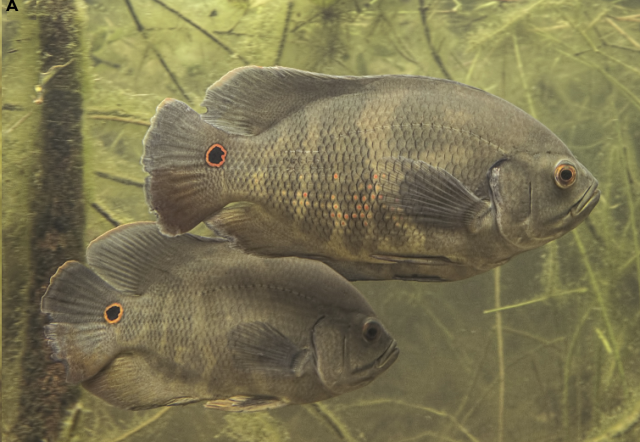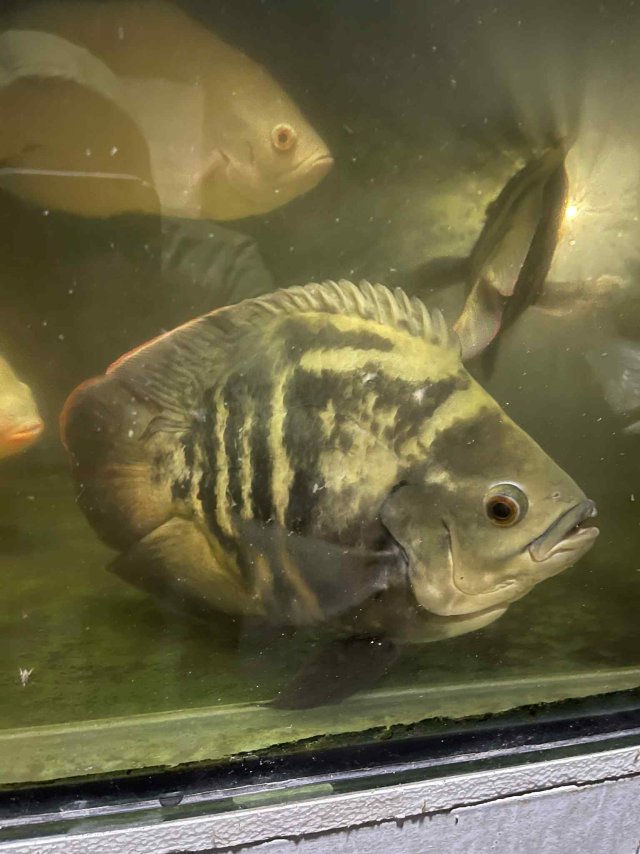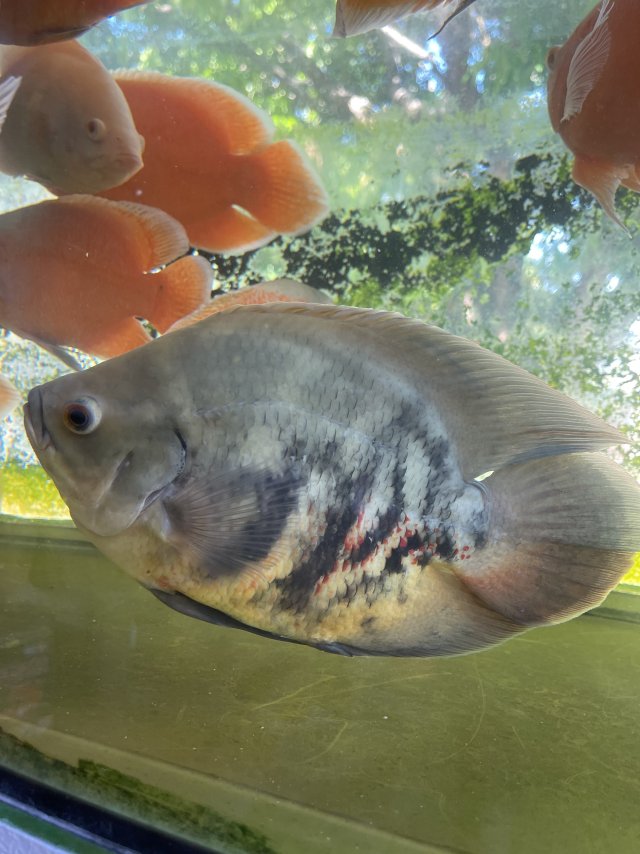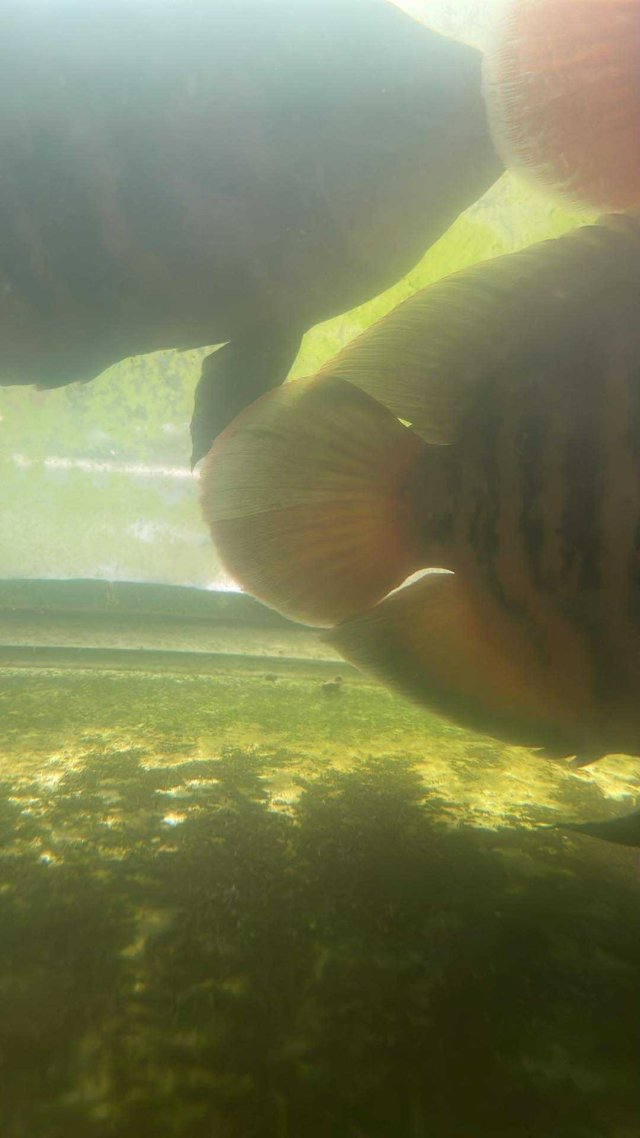You are using an out of date browser. It may not display this or other websites correctly.
You should upgrade or use an alternative browser.
You should upgrade or use an alternative browser.
To me it looks like A mikoljii....from the Rio Negro
The origiinal disription is below...copied from the CRC
But to actually diagnose.. as you can see....is no simple task
Diagnosis: Astronotus mikoljii is distinguished from congeners by the following combination of characters: two or three supraneural bones (versus two); absence of the spinous process (hypurapophysis) on the anterosuperior border of the parahypural bone (hypural complex) in A. mikoljii (versus present in A. ocellatus and A. crassipinnis). The sagitta otolith in A. mikoljiiis oval, with strongly crenulated ventral and dorsal margins (versus elliptical and smooth-lobed margins in A. crassipinnis, and elliptical and smooth-dentate margins A. ocellatus); the rostrum is projected with an elongated process, in A. mikoljii (versus rostrum process short in A. crassipinnis and A. ocellatus); the posterior region of the sagitta otolith is rounded in A. mikoljii (versus straight or flat in A. crassipinnis and A. ocellatus). The aspect ratio of sagitta otoliths in A. mikoljii (AR = 0.665) is higher than that of A. ocellatus (AR = 0.606), and A. crassipinnis (AR = 0.585), and the differences are statistically significant at P < 0.05. The roundness index was highest in A. mikoljii (Rd = 0.597) versus A. ocellatus (Rd = 0.545) and A. crassipinnis (Rd = 0.543) (P < 0.05). Also, the morphometric index showed higher values in A. mikoljii compared to A. ocellatus (0.837 versus 0.767) and A. crassipinnis (0.735). The new species also is distinguished from congeners by the following combination of morphometric characteristics: the mean head length of A. mikoljii (36.72% SL) is longer than that of A. crassipinnis (35.01% SL), and also A. ocellatus (33.26% SL); the mean diameter of the orbit of A. mikoljii (9.06% SL) is greater than that of A. ocellatus (7.36%SL) and that of A. crassipinnis (7.73% SL); the mean pre-orbital depth of A. mikoljii (14.22% SL) is greater than that of A. crassipinnis (10.14% SL) but less than that of A. ocellatus (15.91% SL); the mean snout length of A. mikoljii (11.53% SL) is longer than that of A. crassipinnis (5.36% SL), and A. ocellatus (10.67% SL) (Perez Lozano et al., 2022:123).
The origiinal disription is below...copied from the CRC
But to actually diagnose.. as you can see....is no simple task
Diagnosis: Astronotus mikoljii is distinguished from congeners by the following combination of characters: two or three supraneural bones (versus two); absence of the spinous process (hypurapophysis) on the anterosuperior border of the parahypural bone (hypural complex) in A. mikoljii (versus present in A. ocellatus and A. crassipinnis). The sagitta otolith in A. mikoljiiis oval, with strongly crenulated ventral and dorsal margins (versus elliptical and smooth-lobed margins in A. crassipinnis, and elliptical and smooth-dentate margins A. ocellatus); the rostrum is projected with an elongated process, in A. mikoljii (versus rostrum process short in A. crassipinnis and A. ocellatus); the posterior region of the sagitta otolith is rounded in A. mikoljii (versus straight or flat in A. crassipinnis and A. ocellatus). The aspect ratio of sagitta otoliths in A. mikoljii (AR = 0.665) is higher than that of A. ocellatus (AR = 0.606), and A. crassipinnis (AR = 0.585), and the differences are statistically significant at P < 0.05. The roundness index was highest in A. mikoljii (Rd = 0.597) versus A. ocellatus (Rd = 0.545) and A. crassipinnis (Rd = 0.543) (P < 0.05). Also, the morphometric index showed higher values in A. mikoljii compared to A. ocellatus (0.837 versus 0.767) and A. crassipinnis (0.735). The new species also is distinguished from congeners by the following combination of morphometric characteristics: the mean head length of A. mikoljii (36.72% SL) is longer than that of A. crassipinnis (35.01% SL), and also A. ocellatus (33.26% SL); the mean diameter of the orbit of A. mikoljii (9.06% SL) is greater than that of A. ocellatus (7.36%SL) and that of A. crassipinnis (7.73% SL); the mean pre-orbital depth of A. mikoljii (14.22% SL) is greater than that of A. crassipinnis (10.14% SL) but less than that of A. ocellatus (15.91% SL); the mean snout length of A. mikoljii (11.53% SL) is longer than that of A. crassipinnis (5.36% SL), and A. ocellatus (10.67% SL) (Perez Lozano et al., 2022:123).
Isn’t this the same SB from your last thread?
- YoungLes
- oscar
- Replies: 11
- Forum: Central and South American Cichlids
Yes I have four 6 of them, still unsure what to call it.Isn’t this the same SB from your last thread?
- YoungLes
- oscar
- Replies: 11
- Forum: Central and South American Cichlids
They sold this in many quantity from a supplier it's short body, I just want to confirm it's origin even if it's deformed the patterns looks different.Deformed oscar
So this oscar is sold as Araguaia oscar, most mikoljii has orange pattern at the tail but this one doesnt have.To me it looks like A mikoljii....from the Rio Negro
The origiinal disription is below...copied from the CRC
But to actually diagnose.. as you can see....is no simple task
Diagnosis: Astronotus mikoljii is distinguished from congeners by the following combination of characters: two or three supraneural bones (versus two); absence of the spinous process (hypurapophysis) on the anterosuperior border of the parahypural bone (hypural complex) in A. mikoljii (versus present in A. ocellatus and A. crassipinnis). The sagitta otolith in A. mikoljiiis oval, with strongly crenulated ventral and dorsal margins (versus elliptical and smooth-lobed margins in A. crassipinnis, and elliptical and smooth-dentate margins A. ocellatus); the rostrum is projected with an elongated process, in A. mikoljii (versus rostrum process short in A. crassipinnis and A. ocellatus); the posterior region of the sagitta otolith is rounded in A. mikoljii (versus straight or flat in A. crassipinnis and A. ocellatus). The aspect ratio of sagitta otoliths in A. mikoljii (AR = 0.665) is higher than that of A. ocellatus (AR = 0.606), and A. crassipinnis (AR = 0.585), and the differences are statistically significant at P < 0.05. The roundness index was highest in A. mikoljii (Rd = 0.597) versus A. ocellatus (Rd = 0.545) and A. crassipinnis (Rd = 0.543) (P < 0.05). Also, the morphometric index showed higher values in A. mikoljii compared to A. ocellatus (0.837 versus 0.767) and A. crassipinnis (0.735). The new species also is distinguished from congeners by the following combination of morphometric characteristics: the mean head length of A. mikoljii (36.72% SL) is longer than that of A. crassipinnis (35.01% SL), and also A. ocellatus (33.26% SL); the mean diameter of the orbit of A. mikoljii (9.06% SL) is greater than that of A. ocellatus (7.36%SL) and that of A. crassipinnis (7.73% SL); the mean pre-orbital depth of A. mikoljii (14.22% SL) is greater than that of A. crassipinnis (10.14% SL) but less than that of A. ocellatus (15.91% SL); the mean snout length of A. mikoljii (11.53% SL) is longer than that of A. crassipinnis (5.36% SL), and A. ocellatus (10.67% SL) (Perez Lozano et al., 2022:123).

deformed short-body mikoljii as other have mentioned is likely at least one of the original breeding stock based on band and spot pattern.
While A. mikoljii was only just recently described in 2022, it has been in the hobby labeled as Astronotus sp. Orinoco, or Astronotus sp. Venezuela for decades and seasonal ships out of Colombia. They have been in the hobby for easily 20+ years. TUIC has sent thousands to the Asian and European farms over the years.
The Araguaia oscar is Astronotus crassipinnis. The orinoco and araguaia are separated by thousands of miles, several mountain ranges, several watersheds, and are on completely opposite sides of the Amazon river with the Orinoco being in extreme northwest South America and draining into the Caribbean Ocean just east of the Trinidad/Tabago Island. vs the Araguaia which is the far Southeast near the Brazilian coastline where starts in Alto Araguaia in Mato Grosso draining into the Tocantins in Para which then heads east to the coast meeting up with the short Para river at Belem and dumping into the Atlantic Ocean.
While A. mikoljii was only just recently described in 2022, it has been in the hobby labeled as Astronotus sp. Orinoco, or Astronotus sp. Venezuela for decades and seasonal ships out of Colombia. They have been in the hobby for easily 20+ years. TUIC has sent thousands to the Asian and European farms over the years.
The Araguaia oscar is Astronotus crassipinnis. The orinoco and araguaia are separated by thousands of miles, several mountain ranges, several watersheds, and are on completely opposite sides of the Amazon river with the Orinoco being in extreme northwest South America and draining into the Caribbean Ocean just east of the Trinidad/Tabago Island. vs the Araguaia which is the far Southeast near the Brazilian coastline where starts in Alto Araguaia in Mato Grosso draining into the Tocantins in Para which then heads east to the coast meeting up with the short Para river at Belem and dumping into the Atlantic Ocean.





